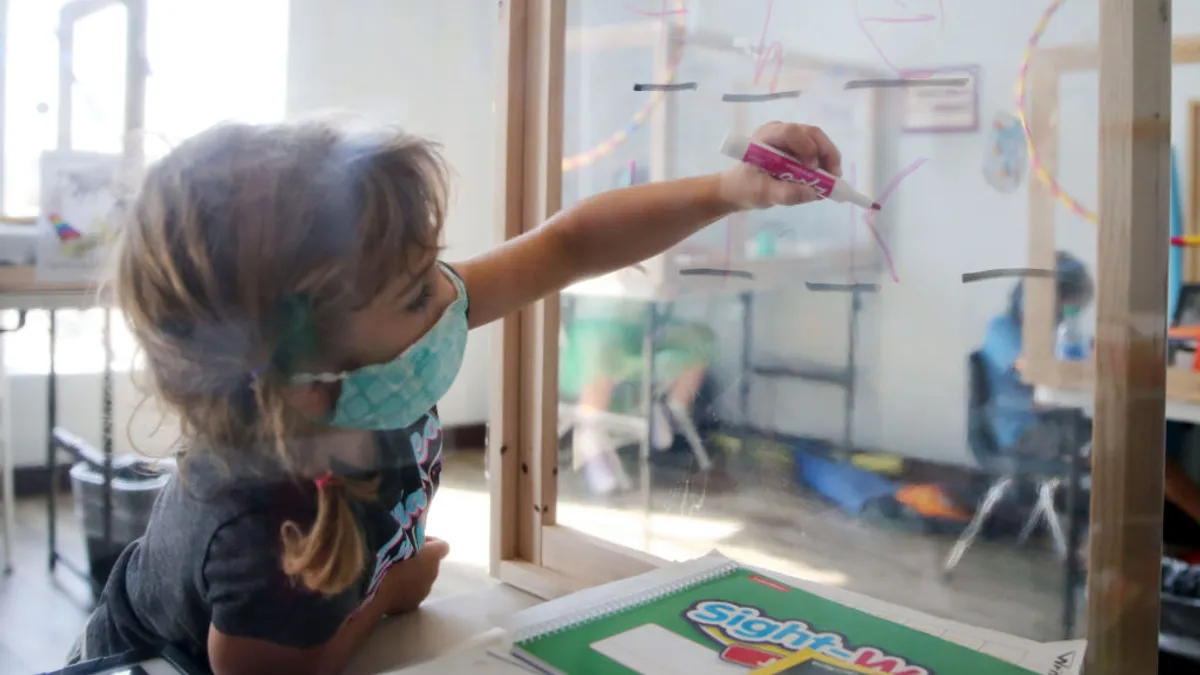Increased access to early intervention services for infants and toddlers at-risk of developing delays and disabilities would help the Part C program under the Individuals with Disabilities Education Act better serve underrepresented populations, according to a FY 2023 budget proposal justification from the White House.
The request comes at a time when Part C enrollment has fallen, likely due to fewer well-child pediatrician visits during the first year of the pandemic. Experts in early childhood development, however, expect Part C enrollment over the next few years to rise to — or even exceed — pre-pandemic levels.
The federal fiscal 2023 budget request allows for a new use of funding under the Part C State Incentive Grant that gives states the option to expand Part C services for at-risk children. It is one of several initiatives by the Biden administration to improve access to high quality early childhood activities. If implemented, supporters say the new allowable funding program could positively impact the K-12 system through earlier access to targeted supports and services.
The $200 million proposal to serve at-risk children under Part C represents almost a fifth of that program's $932 million FY 2023 budget proposal. The total request represents an increase of $435.7 million — or 87.8% — for Part C over the current-year spending plan.
The increase request is a small portion of the total $88.3 billion spending plan for the U.S. Department of Education. Final allocations are determined by Congress. The fiscal year begins Oct. 1.
The intent behind expanding Part C access is to encourage and help states to serve additional at-risk children ages birth through 2 and their families, said Katherine Neas, deputy assistant secretary in the U.S. Department of Education's Office of Special Education and Rehabilitative Services.
For example, Neas said many young children have language delays but their levels of delay might not meet a state's eligibility criteria for Part C services. Those children may need short-term speech therapy to help them no longer be at risk of having a disability. This new initiative under Part C to serve at-risk young children would expedite those services, especially for currently underserved infants and toddlers, she said.
Expediting services for young children at risk of delays or disabilities is what the Ed Department "would want states to be able to figure out a strategy for," she said.
Neas said six states already extend Part C services to children at risk of developing delays. States have flexibility to set different eligibility criteria for their Part C enrollments. States also have the option to participate in Part C, which all now exercise, Neas said.
Having reservations
Part C state coordinators are grateful for the Biden administration's early childhood commitments, but they hold some reservations about potential legislative or regulatory changes in the budget proposal, said Maureen Greer, executive director of the Infant & Toddler Coordinators Association, a membership organization for the coordinators.
Greer said the group is not taking a position for or against the budget plan. She said members do question whether the Part C program is the best entity to coordinate services for at-risk infants and toddlers given that its practitioners specialize in supports for young children with documented delays and disabilities.
"There are other programs that are designed specifically to serve at-risk children like Early Head Start, like home visiting, and we have some concerns that the perception is that Part C should be for all children," Greer said.
"On the other hand, we also know that there is no state or jurisdiction that is serving every single child that is eligible, partly because of funding but partly because of personnel shortages," she said. "And so we want to serve every child that needs our support to change their developmental trajectory."
Part C state allocations are based on the number of children 0-2 in the general population as determined by Census Bureau data. In the 2020-21 program year, 3.2% of infants and toddlers — or 365,715 infants and toddlers — were served under Part C, according to Education Department data.
The 2020-21 program year saw a 17% dip in Part C enrollment from the previous year, according to the budget justification. Pandemic safety precautions and the inability or reluctance to get services in virtual or in-person settings likely caused the drop, said Greer.
Both Greer and Neas expect enrollment to rebound. A recent Infant & Toddler Coordinators Association survey response from Part C coordinators in 43 states shows in this program year, 60.5% are exceeding their 2020 child counts and 30.2% are exceeding their 2019 child counts, Greer said.
The budget justification also states the Education Department anticipates enrollment increases through 2023 as pandemic-related hardships for Part C participation and identification decrease.
"Children returning to the program are likely to have more intensive needs because they could not access the services during the pandemic," the budget document states.
Part C enrollment and programming are activities that pre-K-12 special education administrators monitor as well, said Phyllis Wolfram, executive director of the Council of Administrators of Special Education.
While referral rates for special education services aren't tracked at state and federal levels, CASE members are saying they are experiencing more demand for evaluations to qualify for special education services, Wolfram said.
Greer added that some states are reporting higher Part C referrals than they've ever seen. "I think we are on the right path," she said.






















